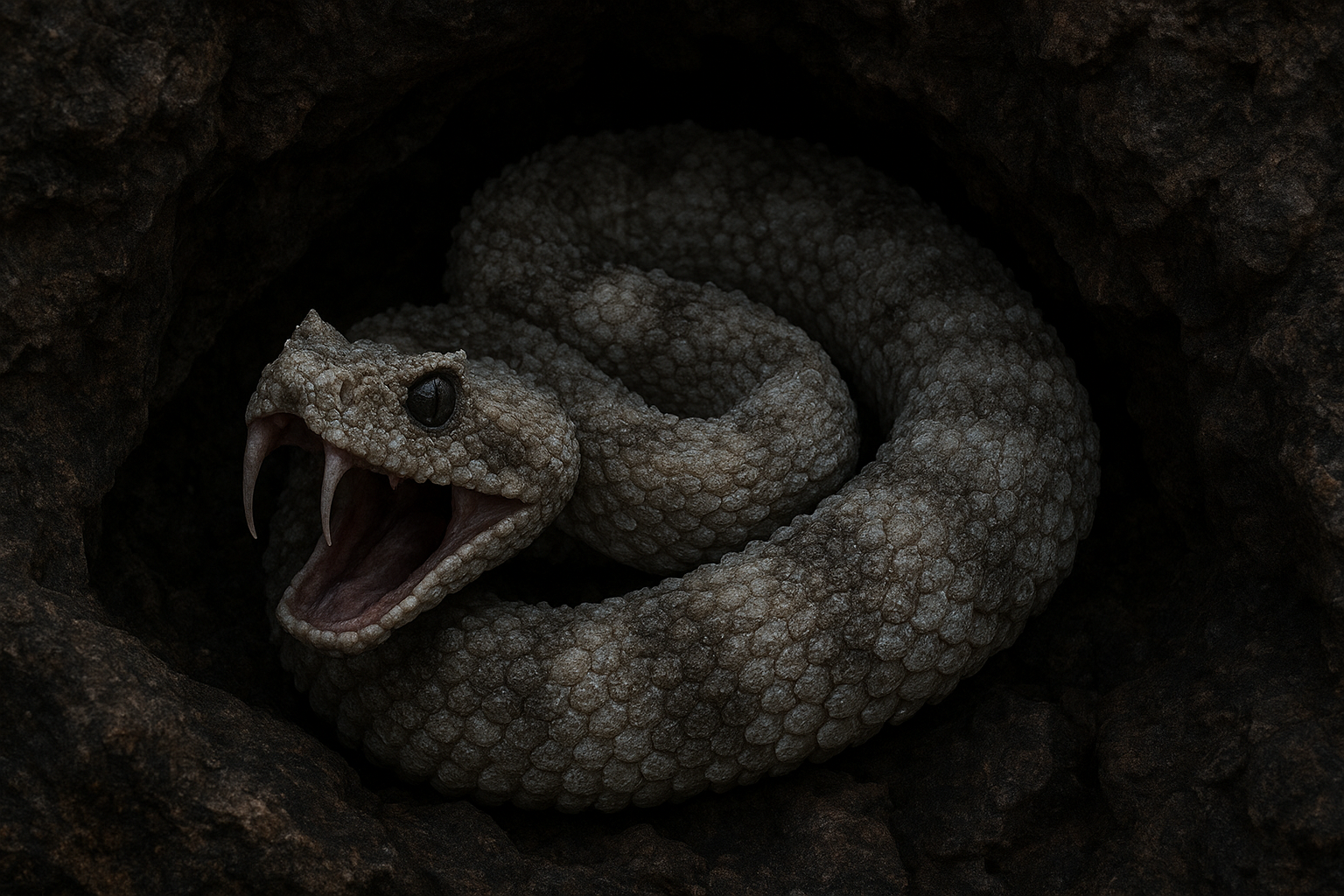Saltvipers
When the sun dips low and the salt plains shimmer like ice, the Saltviper stirs beneath the crust. Travelers often mistake its faint rustling for the crack of cooling rock, only to glimpse a glint of crystalline scales moments before the strike. Its movements are silent, fluid — the motion of something both mineral and alive.
Along the Great Salt Lake, locals tell of the “white whisper,” a serpent that glides through salt beds as easily as a fish through water. “Where the salt bleeds, the viper drinks,” they say, warning newcomers not to wander the flats at dusk.
Saltvipers are frequently mistaken for rattlesnakes, though the differences are plain to the trained eye. Their skin bears a distinct crystalline sheen, refracting light like powdered glass, and each adult possesses a double set of retractable fangs — a rare evolutionary quirk.
Saltviper (Vipera halomorpha)
Family: Viperidae (subfam. Haloviperinae)
Average Length: 1.6 to 3.5 m (adult)
Habitat: Coastal flats, salt beds, tidal basins, and evaporite deserts
Diet: Carnivorous (small mammals, seabirds, carrion, crustaceans)
Distribution: Southwestern United States (notably Utah and Death Valley), coastal regions of the Mediterranean and western India, and scattered populations across artificial salt farms in South America
Description
The Saltviper’s scales are semi-translucent, their surfaces encrusted with fine deposits of sodium and calcium carbonate that lend the snake its signature glittering texture. Under full light, its body appears to shimmer with pale blues and silvers, like sunlight over a frozen lake. This mineral coating serves both as camouflage and protection, insulating the viper from the desiccating heat of its saline habitat.
Beneath its pale armor lies a robust musculature adapted for burrowing. The head is triangular and flattened, the fangs capable of delivering separate venom types — one paralyzing, the other hallucinogenic. The latter, though rarely fatal, induces profound sensory distortion in its victims. Desert hikers describe seeing “the sky melt” or “the ground breathing,” experiences often followed by dehydration or accidental self-injury. Rangers in Death Valley have documented several fatalities caused not by the bite itself, but by the delirious actions of the bitten.
Distribution & Habitat
Though early records placed Saltvipers along Mediterranean coasts and Red Sea tidal flats, the species is now known to thrive across the arid salt beds of the American Southwest. The densest known populations are found in Utah, where they burrow beneath evaporite crusts and hunt by vibration. In recent decades, however, biologists have noted a concerning population surge within Death Valley National Park, where changing climate patterns and human migration have expanded the viper’s viable range.
In these desert environments, they play an unexpected ecological role — controlling populations of rodents and small scavengers that feed on salt-crusted carcasses. Nocturnal cameras have captured Saltvipers lying half-submerged in mineral pools, their scales glinting faintly under the moonlight like submerged shards of glass.
Behavior & Ecology
Saltvipers are solitary ambush predators. During the day, they remain buried beneath salt crusts, emerging at dusk when cooler air allows easier movement. Their double venom system is a potent adaptation: the paralytic venom immobilizes prey, while the hallucinogenic compound distorts perception, often causing small mammals to wander directly back toward the predator’s hiding place.
The same neurochemical properties that aid in hunting have made the species a subject of illicit interest. Extracts of Saltviper venom have occasionally appeared in fringe pharmacological markets under names like White Mirage or Desert Sleep, prized — and feared — for their hallucinogenic intensity.
Saltvipers are social only during mating season, when pairs can be seen entwined on the open flats, scales refracting starlight like mirrored glass. The female guards her clutch within shallow burrows until the hatchlings emerge — small, glassy, and nearly invisible against the salt.
Human Interaction & Myth
Saltvipers occupy a strange space in human lore — part menace, part mirage. The Indigenous Paiute peoples of the Great Basin tell of T’oa-ni, the “Salt Spirit,” who punished those who wasted water by leading them in circles across the flats, their minds clouded by shimmering visions. Early Mormon settlers dismissed these stories as superstition until a series of deaths in the 1890s, attributed to “desert madness,” revived belief in a venom that made men “see heaven on the ground.”
At Wit’s End
Though not native to Sorbet County, a small number of Saltviper sightings have been recorded near Moonfall Lake to the east of Garrett’s Hollow, likely transported long ago via cargo shipments of rock salt. Their presence has already disrupted several native rodent populations. Should they establish a breeding colony, the consequences for both local ecology and human safety could be severe.
